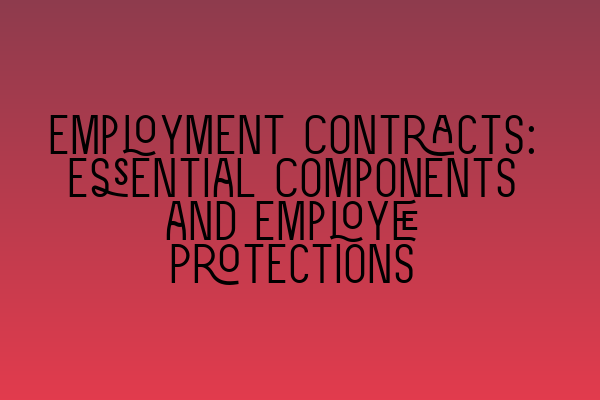Employment Contracts: Essential Components and Employee Protections
When it comes to employment agreements, it is vital for both employers and employees to have a clear understanding of the essential components and employee protections that should be included. This ensures that the rights and obligations of both parties are properly outlined and protected.
In this article, we will delve into the key elements that make up a comprehensive employment contract and explore the various legal protections available to employees. Whether you are an employer or an employee, understanding these components will help you navigate the employment relationship with confidence.
1. Basic Information
Every employment contract should start with the basic information of the parties involved. This includes the names and addresses of both the employer and the employee, as well as the start date of the employment.
MCQ Practice Quiz: Test your knowledge on employment law basics!
2. Job Title and Description
Next, the employment contract should clearly state the job title and provide a detailed description of the employee’s responsibilities and duties. This section is crucial as it sets the expectations for the employee’s role within the organization.
Practice Mocks FLK1 and FLK2: Get familiar with real-world employment scenarios!
3. Hours of Work and Location
Employment contracts should specify the regular hours of work, including any required overtime or flexible work arrangements. It should also determine the location where the employee is expected to perform their duties, whether it is on-site, remote, or a combination of both.
4. Compensation and Benefits
The contract should outline the employee’s salary or wage, including any bonuses, incentives, or commission structures. It should also detail the benefits package, such as health insurance, retirement plans, vacation days, and sick leave entitlements.
SQE 2 Preparation Courses: Enhance your understanding of employment contracts and other legal topics!
5. Termination and Notice Period
To protect both parties, employment contracts should include provisions regarding termination. This includes the notice period required for both the employer and the employee when terminating the agreement. It should also define the grounds for termination, such as performance issues or misconduct.
6. Confidentiality and Non-Disclosure
In many industries, confidentiality and non-disclosure agreements are crucial to protect sensitive information. Employment contracts should include clauses that address the confidentiality of company secrets, client data, and any proprietary information that the employee may have access to during their employment.
7. Intellectual Property
If the employee’s role involves creating intellectual property, such as inventions, designs, or creative works, the employment contract should clearly state who owns the rights to these creations. This protects the interests and ownership of both the employer and the employee.
8. Dispute Resolution
It is essential for employment contracts to include provisions for resolving disputes that may arise between the employer and the employee. This could involve mediation, arbitration, or other alternative dispute resolution methods. Clearly outlining the process for resolving conflicts helps to minimize potential legal battles.
SQE 1 Preparation Courses: Prepare for the legal profession with comprehensive SQE 1 courses!
Employee Protections
Employment contracts not only outline the rights and obligations of the parties involved but also provide legal protections for employees. Here are some key protections commonly found in employment contracts:
1. Equal Opportunity and Non-Discrimination
Employment contracts should include provisions that promote equal opportunity and prohibit discrimination based on factors such as race, gender, age, religion, disability, or sexual orientation. These protections ensure a fair and inclusive work environment.
2. Health and Safety
Contracts should incorporate health and safety policies to protect employees from work-related hazards and ensure a safe working environment. This includes provisions for training, equipment, and procedures to mitigate risks and prevent accidents.
3. Grievance and Complaint Procedures
Employees should have access to internal grievance and complaint procedures through their employment contracts. These processes allow employees to raise concerns or complaints without fear of retaliation and provide a mechanism for addressing and resolving workplace issues.
Conclusion
In conclusion, employment contracts play a crucial role in establishing a mutually beneficial relationship between employers and employees. By including the essential components discussed above and incorporating employee protections, both parties can enter into an employment agreement with confidence and clarity.
SRA SQE Exam Dates: Stay updated with the latest exam dates for SRA SQE exams!
